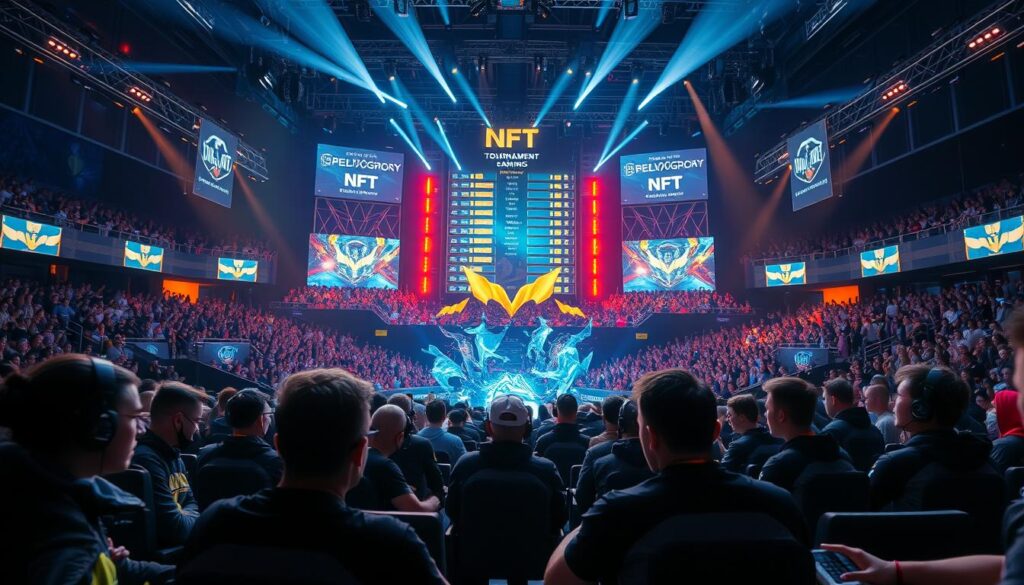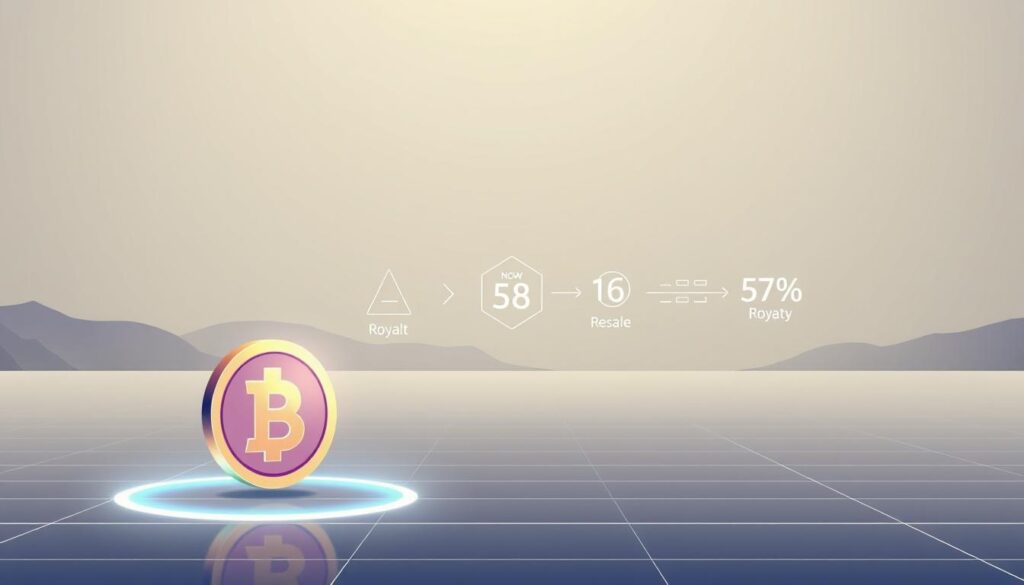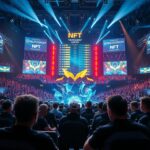Now Reading: Explore the Captivating Realm of Generative Art NFTs
- 01
Explore the Captivating Realm of Generative Art NFTs
Explore the Captivating Realm of Generative Art NFTs
Imagine a world where creativity meets code, producing one-of-a-kind digital masterpieces. This innovative approach to design traces its origins to the 1960s Dada movement, when artists like Harold Cohen first experimented with computer-controlled robots to create paintings. Today, this method has evolved into a groundbreaking fusion of technology and tradition, reshaping how we value and collect digital works.

At its core, this form of art relies on algorithms to generate unpredictable patterns, colors, and shapes within frameworks set by creators. The rise of blockchain technology has transformed these digital creations into verifiable assets, sparking a revolution in the thriving digital economy. Collectors now seek pieces that blend human vision with machine-generated randomness, creating endless variations from a single artistic blueprint.
What makes these works truly unique? They combine structured rules with chaotic elements, producing outcomes even the artist can’t fully predict. From repeating geometric motifs to vibrant color palettes, each piece tells a story of collaboration between creator and code. As highlighted in this comprehensive guide, the marriage of autonomous systems and blockchain verification has opened new frontiers for both artists and investors.
Key Takeaways
- Origins trace back to 1960s experimental artists like Harold Cohen
- Combines preset rules with algorithmic randomness for unique outputs
- Blockchain technology enables ownership verification and scarcity
- Features repeating patterns and unpredictable compositions
- Creates new economic models for digital creators
Unraveling the Origins and Evolution of Generative Art
The story of code-driven creativity begins with radical thinkers challenging traditional methods. In the 1960s, innovators like Harold Cohen bridged painting and programming, using robots to produce works that blended logic with spontaneity. This era marked a seismic shift—artists became architects of systems rather than direct creators.

Historical Milestones and Influences
Early experiments drew inspiration from Dada’s embrace of chaos. Pioneers developed rule-based frameworks where machines interpreted instructions uniquely each time. By the 1970s, geometric patterns emerged from collaborations between artists and clunky mainframes, proving technology could be a creative partner.
The Role of Algorithms and Early Experiments
Cohen’s robotic painter “AARON” demonstrated how algorithms could generate endless variations. These systems required artists to design parameters for color, shape, and composition while leaving room for computational randomness. As tools evolved, creators gained finer control over their digital assets, setting the stage for today’s dynamic works.
Three principles defined this movement:
- Systems over singular outcomes
- Controlled unpredictability
- Collaboration between human and machine
From punch cards to Python, each technological leap expanded possibilities. What began as mathematical curiosities now fuels a global revolution in how we define authorship and value in creative works.
The Rise of Generative Art NFTs in the Digital Landscape
The digital art world transformed when code-based creations met blockchain verification. This fusion turned fleeting digital files into scarce, tradable assets. Early innovators bridged algorithmic design with decentralized networks, rewriting rules for ownership and value.

Transitioning from Traditional Art to Blockchain-Based Creations
Kevin McCoy’s 2014 “Quantum” marked a turning point. This pulsating abstract piece became the first NFT to combine generative code with blockchain registration. Unlike physical art, its ownership could be instantly verified—a radical concept at the time.
Traditional galleries struggled with digital provenance. Blockchain solved this by embedding creation data and transaction history into each token. Artists gained control over royalties through smart contracts, while collectors secured immutable proof of authenticity.
Kevin McCoy, Larva Labs, and Pioneering Projects
Larva Labs built on this foundation with 2019’s Autoglyphs. These algorithmically generated ASCII artworks lived entirely on Ethereum’s blockchain. Each piece’s code produced unique patterns, establishing key concepts still used today:
- Limited editions enforced through smart contracts
- Transparent rarity systems
- Decentralized storage for permanent access
The project’s success proved that code-driven collections could achieve both artistic merit and market demand. Auction prices for early works now reach millions, demonstrating blockchain’s power to redefine creative economies.
Generative Art NFTs: Creating, Minting, and Thriving in the Digital Space
Crafting digital collectibles begins with structured chaos. Artists design rulebooks for machines, defining color ranges, shape hierarchies, and pattern interactions. These frameworks become playgrounds where algorithms mix elements unpredictably, producing thousands of distinct outputs from a single blueprint.
Understanding the Creative Process and Automated Algorithms
To create generative works, developers first build asset libraries. A collection might include 50 base shapes and 200 texture variations. Code then assembles these components using weighted randomness—a system favoring certain combinations while allowing surprises. For example, rare traits might appear in only 1% of outputs.
Blockchain integration elevates this process. Smart contracts trigger artwork generation during minting, ensuring each piece forms uniquely upon purchase. This approach solves duplication risks while letting collectors participate in the creation journey.
Successful projects balance three elements:
- Cohesive visual rules
- Controlled randomness thresholds
- Blockchain-executed rarity systems
Artists test their code extensively before launch. They simulate outputs to verify aesthetic consistency and rarity distribution. Platforms like Ethereum then host the final product, where transparent ownership records meet algorithmic wonder.
Tools, Platforms, and Resources for Generative Art
The ecosystem for code-driven creativity thrives on specialized toolkits that empower creators. From open-source frameworks to blockchain marketplaces, these resources shape how digital assets come to life. Artists balance technical precision with artistic vision using tools designed for both experts and newcomers.

Popular Coding Libraries and AI-Powered Art Generators
Developers rely on libraries like p5.js and openFrameworks to build intricate systems. JavaScript’s Canvas-sketch framework helps creators design dynamic patterns, while Cinder enables complex 3D rendering. These tools let artists set parameters for color, shape, and motion—then watch algorithms generate unexpected results.
Artificial intelligence expands possibilities through platforms like Midjourney. Users input text prompts to produce striking images, blending human ideas with machine interpretation. Dall-E’s neural networks analyze millions of visuals to create original compositions, offering new ways to experiment with form and texture.
Leading Marketplaces and Specialized Platforms
Art Blocks dominates as the premier platform for algorithm-based collections. Its Ethereum-based system ensures each piece generates uniquely during purchase. Fxhash offers a Tezos alternative with lower fees, attracting artists focused on sustainability. Both platforms verify ownership through blockchain technology.
No-code solutions like Async Art simplify the process for creators without programming skills. Users combine pre-made layers to build evolving digital assets. As tools evolve, cross-platform compatibility and improved interfaces make this space more accessible than ever.
Market Trends and the Economic Impact of Generative Art NFTs
The intersection of code and commerce has birthed a new asset class. Art Blocks dominates this space with $1.3 billion in lifetime sales, proving algorithm-driven works hold real-world value. Collectors now analyze transaction histories like stock portfolios, hunting for pieces with rare traits and historical significance.
Investment Dynamics and Collector Behavior
High-profile sales reveal strategic buying patterns. When Ringers #109 sold for $6.9 million, it wasn’t just about aesthetics—the piece combined early-project status with unique algorithmic outputs. Buyers prioritize three factors:
- Mathematically rare trait combinations
- Artist reputation within crypto communities
- Historical relevance to blockchain art movements
Traditional art investors increasingly collaborate with crypto natives. This hybrid approach reshapes valuation models, blending aesthetic critique with smart contract analysis.
Scarcity, Rarity, and the Value Proposition
Limited editions drive demand through verifiable scarcity. Autoglyphs maintain value because only 512 exist—each generated directly on-chain. Projects use clever mechanics:
- Time-locked releases creating urgency
- Algorithmic trait probability under 1%
- Burn mechanisms reducing supply over time
Market volatility remains a concern. While Fidenza collections gained 400% in 2021, some projects saw 80% drops during crypto winters. Savvy collectors diversify across established artists and emerging creators to balance risk.
Showcasing Notable Generative Art NFT Projects
The digital collectibles space shines brightest through its groundbreaking projects. These works demonstrate how code-based creativity can achieve both technical brilliance and emotional resonance. Three collections stand out as defining moments in blockchain-powered artistry.
Autoglyphs: The On-Chain Revolution
Larva Labs redefined permanence with their 2019 ASCII artworks. Each piece generates directly on Ethereum’s blockchain, ensuring no external storage dependencies. Only 512 exist, making them coveted by serious collectors.
Fidenza: Algorithmic Fluidity
Tyler Hobbs’ swirling color fields became instant classics. The collection’s 999 pieces showcase unique interactions between fluid shapes and structured patterns. Rare outputs with “grayscale” or “double helix” traits command premium values at auction.
Lost Poets: Narrative Meets Code
Pak’s ambitious project blends storytelling with algorithmic generation. Owners become active participants in an evolving digital saga. The work challenges traditional notions of authorship through its layered, interactive design.
Other milestones include Chromie Squiggles’ playful generative lines and Ringers’ geometric string art. These collections prove that when technology and creativity collide, the results can reshape entire creative industries.
FAQ
How do algorithms shape blockchain-based digital creations?
Algorithms act as programmable rulesets, guiding the creation of unique outputs through code. Artists define parameters, and automated systems generate variations, resulting in one-of-a-kind pieces stored on decentralized ledgers like Ethereum.
What distinguishes Autoglyphs from other algorithmic collections?
Autoglyphs, created by Larva Labs, were the first on-chain generative series built directly into Ethereum’s blockchain. Unlike many projects relying on external files, their code and artwork exist entirely within smart contracts, ensuring permanence.
Why do collectors value rarity in algorithmically produced works?
Scarcity drives demand, especially when traits or patterns emerge unpredictably. Projects like Tyler Hobbs’ Fidenza use controlled randomness, making certain visual outcomes statistically rare—a key factor in secondary market valuations.
Which platforms support the minting of code-driven digital assets?
Art Blocks dominates as a curated hub for generative projects, while Async Art enables programmable layers. Foundation and SuperRare also host algorithmically generated drops, often integrating real-time bidding systems.
How did Kevin McCoy influence blockchain-based artistic innovation?
McCoy’s 2014 “Quantum” prototype introduced the concept of linked ownership for digital works, paving the way for ERC-721 standards. His experiments demonstrated how cryptographic tokens could authenticate unique virtual pieces.
Can AI tools like DALL-E create collectible blockchain assets?
Yes—platforms like BrainDrops integrate AI image generators with NFT minting. However, purists often differentiate between AI-assisted outputs and purely code-based systems like p5.js or Processing frameworks.
What risks accompany investments in algorithmically generated tokens?
Volatility remains high, with prices swayed by crypto market shifts and speculative trends. Projects lacking strong artistic vision or community engagement often struggle post-launch despite initial hype.















